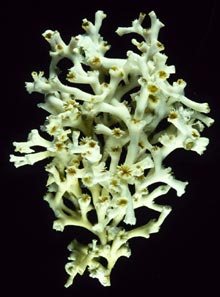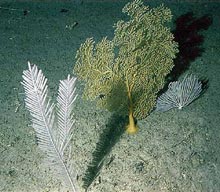
Dr. William Schroeder has documented several occurrences of Lophelia in the Gulf of Mexico. He will be assessing the spatial distribution of these communities using the remotely operated vehicle. Image courtesy of Dr. Andre Friewald, Institute of Paleontology, Erlangen University, Germany. Click image for larger view.
Diversity of Deep Sea Corals
Peter Etnoyer, Scientist
Sponsored by the Marine Conservation Biology Institute
One of the values we attach to marine and terrestrial ecosystems is “biodiversity.” In a bioprospecting sense, biodiversity recognizes the unique genetic composition of each and every species. In an ecological sense, biodiversity recognizes and appreciates all the species in a healthy ecosystem, the niches they fill, and the habitat functions they perform. Deep-sea corals are an important part of deep-sea ecosystems because their branches provide refuge to associated species, including fish, crabs, shrimp, and basket stars. Some skates (a cross between a shark and a ray) are known to lay their eggs on bubblegum corals (Paragorgia sp.). Skates need these corals in the same way that eagles need trees.
Deep-sea corals are long-lived, slow-growing archives of global change, uniquely adapted to life in extreme environments. We are only beginning to understand their diversity, range and distribution in United States waters. One of the objects of this cruise is to document the diversity of deep sea corals in the Gulf of Mexico. Last year, we documented over 100 species in the Northeast Pacific, more than the number of hard coral species in the entire Caribbean Sea! We found very different communities than those in the Atlantic and Caribbean.
Our understanding of a species range and distribution (or biogeography) is limited by the extent of the collections we keep in our museums. If no one from Alaska bothered to send a coral species to the Smithsonian Institution National Museum of Natural History or the California Academy of Sciences, for example, we would not know that deep-sea corals exist in Alaska. Fortunately, Alaskan scientists and fisheries observers keep good records. We have a good understanding of the many species found in those cold, dark waters.
A biogeographic database can be biased by the type of collections sent to a museum. Lophelia pertusa is one of the best documented species in the Gulf of Mexico and the South Atlantic Bight. This may be because they are the most abundant species, and are thriving in their best habitat, or perhaps because they are the easiest specimens to collect. The issue of bias is a particular problem for deep-sea exploration, because the history of submersed exploration is measured in decades rather than centuries. Many of our samples come from relatively shallow waters. We now have the capacity to dive to the greatest depths.

Acanella sp., bamboo corals in the family Isididae, are documented in our study area, but are often found quite deep. To learn more about Bamboo Corals. Click image for larger view.

Two octocorals (Callogorgia sp. and Narella sp.) flank a yellow gorgonian (Acanthogorgia striata) at 355 m depth near Hawaii. Callogorgia sp. (left) is documented in our study area. Narella sp. is documented in the Gulf of Mexico, but not in our study area. Photo courtesy of Hawaii Undersea Research Lab, via Dr. Scott France’s Web site at University of Charleston. Click image for larger view.
On this expedition, we will use an on-board geographic database of habitat- forming deep-sea corals to compare to the species we encounter. This database documents at least 20 species of black corals (Antipathes sp.) in our study area, but only a few species of bamboo corals (Acanella sp.) and primnoids (Callogorgia sp.). We will be asking the question, “How well does our understanding of deep-sea coral diversity reflect what’s really down there?” If most of the species we collect in the Gulf of Mexico are already documented, we might answer “pretty well." If we find species where they were never known before, as often happens, we had best keep looking!





















